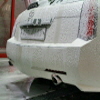Boards
글 수 27,499
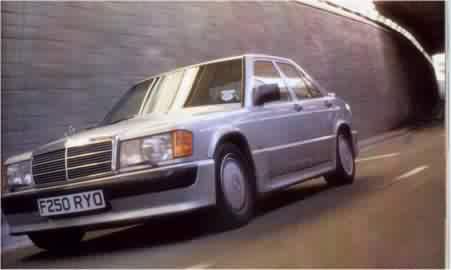
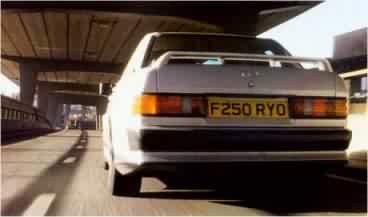
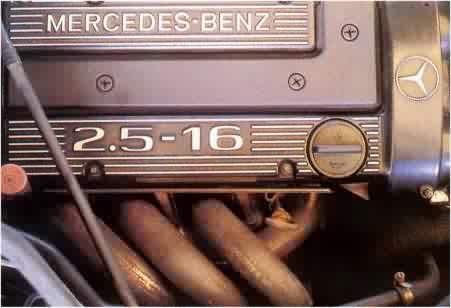
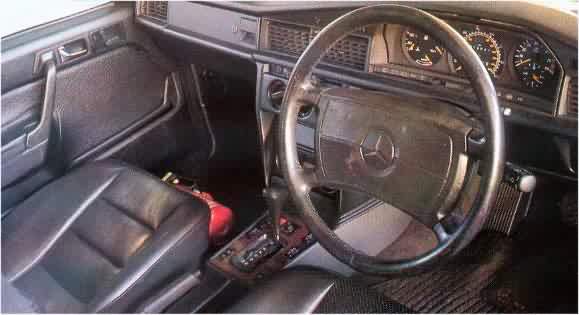
. BENZ
THE
RULES
Article first published in classiccars February 2000.
Think Mercedes Benzand motor sport, and you might think Mika Häkkinen and Formula One, if you're a Nineties child, or you might think Stirling Moss and sports cars, if your heart is in the Fifties and the Mille Miglia. But set the clock in the late Seventies and early Eightis and try to think of a sporting threepointed star, and chances are you'll draw a blank - after generations of sporting achievement, Mercedes Benz had slowly sunk into a world of first rate engineering, reliability and Teutonic thoroughness, as the builders of the finest taxis and euro-bargers of the world: but Benz had also become synonymous with middle class conservatism, driver appeal and competition prowess were no longer high on the list of the corporates goals.
Until the Mercedes 2.3-16 came along. In a generation of lookalike safe saloons and autobahn cruisers, in 1983 Mercedes produced one of the most unusual, non-comformist and unexpected sporting cars in its long history - and what's more, they built it for one of the most unexpected reasons of all: Mercedes Benz was going to rallying.
THIS HEAVYWEIGHT four-door saloon might seem a ludicrous rally hopeful now, but we see it with the benefit of Audi quattro hindsight - back in 1979, when this car was conceived as the top of the 190E range, the rear-wheel drive 2.3-16 was considered a credible way back into international motor sport. Its chassis was deemed capable, its weight distribution adequate and its position at the bottom of the Mercedes saloon range absolutely perfect for maximum PR effect. All Mercedes needed was an engine, and this is where the 2.3-16 broke all the rules. Renowned for its solid engineering skills, Mercedes nevertheless chose to seek outside technical expertise for beefing up the 190, from Cosworth Engineering of Northampton. Cosworth admits it was amazed to get the phone call from Stuttgart, but in fact it made perfect sense. Not only was Cosworth a safe bet as a technical partner in the planned re-entry into motor sport, it had also proved itself an expert in producing reliable four valve combustion engines, a technology still in its infancy in mass production. Mercedes had a reasonably powerful six-cylinder engine at hand, but it needed something less laconic, more fiery for its racer, and so it delivered its standard M102, four-cylinder 2.3-litre block on Cosworth's doorstep, and commisioned a 16-valve cylinder head. And the 2.3-16 was born.
The car was launched at the Frankfurt show late in 1983, a month after a prototype had completed eight days and nights flat-out driving at the Nardo test track in Italy, setting several speed and endurance records, and fuelling press anticipation. It might have looked as conservative as any other Mercedes on the show stand, but its specifications was impressive. Its double overhead-cam engine produced 177 bhp - up from the standard car's 122 bhp - and it had a claimed top speed of 141mph. Mercedes had added a Getrag five-speed gearbox, with a dog-leg first, to the equation, and Cosworth themselves manufactured the first cylinder heads.
As a road car the 2.3-16 did surprisingly well, but plans to conquer rallying were aborted - Mercedes had been overtaken by events, and the four-wheel drive era was already under way when the car was launched. In the end 17.037 2.3-16s were produced, until 1988 when Mercedes upgraded to the 2.5-16 - a simple development, as the 2.5-litre block was already there, and Mercedes itself had since taken control of the cylinder-head production in-house.
It is a 2.5-16 you see here. In fact this is one of the rarest of the breed. When new, the 2.5-16 was pricey in the UK, and a bit sporty for the average, conservative Merc buyer. At £38,272 all in, the 2.5-16 proved too rich for the upwardly mobile young thruster, especially when the BMW M3 weighed in around £30,000. The upshot of this is that not many Cosworth-engined Mercedes were sold in the late Eighties and early Nineties - just 4784 2.5 models were produced in total, and between 170 and 500 found their way to these shores each year until the model's eventual demise in 1992.
Looking relatively low-key in comparison to today's flared and fluted swollen road-rockets, many 2.5s have been through the boy racer school of abuse, with oversized alloy wheels and dropped suspension. Tread very carefully, though, and you may find one that has been looked after by a Merc aficionado. One of the best ways of ensuring this is to find an automatic, an alternative to the five-speed manual, offered only on the 2.5, and taken up by 35% of 2.5-16 buyers - the Getrag box might be sporty, but it's awkward for the right-hand drive model, and not exactly keeping with the typical Mercedes driver.
THIS CAR belongs to Tony Montalbano. He is known in Mercedes circles as the specialist's specialist. With piercing blue eyes, a London accent and quiet demeanour, it's a surprise to find he is of Sicilian descent - although his mobile phone rings to the theme tune of The Godfather. In the Sixties, Tony began his apprenticeship at Maranello Concesionaires working on exotic Ferraris; he then moved to a Mercedes main dealer for ten years before setting up his own Mercedes dedicated workshop, TM Motors, 20 years ago.
'Cosworth 2.5s make great everyday cars.' he explains. 'They don't have any real vices. The valve chains on early 2.3s can snap but this is due to poor maintenance rather than a design fault. The problem is that some younger owners fit bigger wheels and lower the suspension on their cars. But this leads to damaged driveshafts and hub bearings and messes up the ride and handling. They are developed enough already, so it's best to leave them alone.'
This 1989 Astral silver Merc looks compactand lean and classy, but the body kit is hard-edged and very Eighties. These cars are sensitive to colour and look their best in silver or dark metallic grey. The original flat alloy wheels are thankfully tasteful and shod with 205/55 Pirelli rubber. The rear wing, sideskirts and front spoilers are, of course, totally functional and confer a respectable drag co-efficient of 0.32 on the otherwise straight-up-and-down saloon. With 80.000 miles on the clock its exterior is near perfect - only the grey plastic door handles look a little faded - while the interior is trimmed in black leather and looks like new, if a little oppressive. It is fully loaded with air conditioning, cruise control, heated seats, airbags, a sound system and, in this car, that automatic transmission.
Entering the cabin I'm gripped by firmly bolstered, tightly hugging seats nicely inspired by Ms Whiplash. Driver ergonomics are pure Mercedes, with clear instruments and an overly large steering wheel that a Vintage enthusiast would enjoy. The car's sporting nature is affirmed with the addition of an oil temperature gauge and stopwatch.
Start the engine and it settles down to a reasonable idle, but I'm aware of four very big pistons at work. The engine is tappety, which is as it should be according to Tony. The accelerator feels typically wooden at first, but the deft little gearshift lever, with its clearly demarcated gate, clicks lightly into Drive, and I have a sports or economy option to choose from. On the move, the Merc feels solid an taught, power steering is meaty and full of feel, and through the suburbs the 'box shifts seamlessly into top. Tony says that it's very difficult to get the manual cars to idle cleanly because of all the valves and cams, but this is made easier with the added drag of the automatic.
The car remains quiet and unobtrusive and, initially, the engine note is uninspiring, sounding dull and flat - switching the gearbox to sports mode should help. Tony explains that the automatic must be correctly adjusted; when he first bought the car it was reluctant to hold onto high revs, but careful fettling has overcome this annoyance and now it does as it's told. It takes time to get used to the leaden Merc throttle, however, and to summon any action it needs a lengthy prod. As the road clears I put the boot in, a cog is dropped and the Cosworth credentials are revealed. The engine hardens and starts to bark, the 16 valves love revs and, awakened and breathing hard, the little Merc comes on strong, the rev counter soaring around the dial to the 6800rpm limit. At higheer revs, the double overhead cams instruct the 16 valves with passion and this plain saloon transforms itself into a sports car. With a slurring shift the next gear continues to bring in the power and all 204 horses - the same number a Porsche 911SC has to play with, start to crescendo. This is serious stuff. Not as roygh and uncouth as Ford's notorious Sierra Cosworth, but damned impressive just the same.
In the real world the Mercedes four-speed auto is almost peerless. Where the standard five-speed dog-leg 'box has hugely long ratios and is notchy and vague in operation, the auto has a gearlever that can be palmed just like a manual, enabling me to control the revs with exactitude: it also has shorter gearing, which is better-suited to British roads and effectively masks the engine's mediocre levels of low-end torque, while remaining keen to kick down and spool up lungfuls of revs, hanging on well past the red-line.
This is when I begin to get the picture. The 2.5-16 is no Jekyll and Hyde schizophrenic, it's too well-bred for that. But let it rev and the urban cruiser transmutes into a hard and aggresive autobahn stormer. The chassis and suspension are well able to cope with the sweet-revving engine. As the speed rises, reactions improve and the Merc sharpens: initial understeer is present but with more cornering commitment I'm soon on nodding terms with oversteer. Then the electric cuts in: the electronically controlled limited-slip differential keeps the tail where it should be, but in a modern classic capable of hitting 60mph from rest in a little more than eight seconds and topping out at 150mph this is perfectly in character, and allows for quick and safe travle. The technically advanced multi-link suspension and electronic gadgetry keeps the 2866lb car fasy, fluid and even furious if need be, while excess speed is effectively reined in by the powerful ABS-equipped brakes.
Once in the urban jungle I let the auto 'box take the strain, and enjoy the sounds of the excellent Becker CD player. In traffic-clogged central London the Merc is a relaxed and smooth companion, bereft of driveline shunt or wind-up. Here, it's as comfortable as any the bigger Merc limos but with much quicker reactions. It's smaller bulk means gaps in the traffic are mine for taking with a lazy prod of the schnell pedal.
THE 2.5-16 is a cracking good car. When new it was too expensive, but has become much more affordable:£10,000 will get you a good exmple of this exclusive, baeutifully finsihed and intelligently engineered machine in the true Mercedes tradition. It is totally relaxed in the cut and thrust of today's traffic, but find a fast and open road and you'll discover the depths and delights of the extraordinary engine and enourmously competent chassis. The boffins at Cosworth, who have never paid much attention to any book of rules, have added true excitement to this three-pointed star.
But what of the car's racing credentials? After a star-studded debut at the Nürburging it took Mercedes five years to find the Cosworth a racing home, but thenm in 1988 when the silver and black AMG cars entered the DTM series (The German touring car championship) the 16-valve finally realised the racing potential that was always there: over the next five years, the Cosworth won 50 races in total, taking several championships, and as late as 1993, its last season, it was still a race winner. Perhaps Mercedes' rally plans weren't so daft after all.


